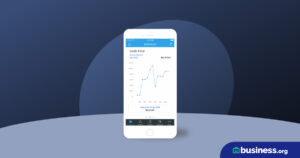💸 See if your business qualifies for a tax credit worth up to $26k per employee. 📞 Call Now: 855-979-9597
What Is a Cash Flow Statement?
We are committed to sharing unbiased reviews. Some of the links on our site are from our partners who compensate us. Read our editorial guidelines and advertising disclosure.
A cash flow statement is a crucial financial document that details all your sources of cash over a given period of time. It also breaks down where you've spent that money so you can see if your business is making more money than it spends.
Your cash flow statement is one of your business’s most important financial statements. Along with your profit and loss statement and balance sheet, it shows whether your business is on the path to success, and if not, how you can get back on track.
Let's explore what information a cash flow statement includes, how you can create one, and why tracking cash flow should be at the very top of your accounting to-do list.
What information is on a cash flow statement?
Cash flow statements sound pretty basic. First, they list all of your business's sources of cash, including sales and investments. Then they list everything you spend money on, such as employee salaries, debt payments, and equipment maintenance.
But since this is accounting we're talking about, creating a cash flow statement isn't quite as simple as it sounds. (Don't worry—we're 100% confident you can figure it out with a little help.)
Cash flow statements split your inflow and outflow of cash into three main categories:
- Cash flow from operating activities
- Cash flow from investing activities
- Cash flow from financing activities
Cash flow from operating activities means all cash that comes from or goes into your business’s daily operations. You can also think of cash from operating activities as cash related to revenue, so any money you spend or make on a product, plus any wages you pay workers who help make that product, falls under this category. So do income taxes, rent payments, interest rates, and any other cash flow that impacts how much money your business earns in daily profit.
Cash flow from investing activities means any cash earned or lost on activities like buying or selling an asset—say, a piece of property or equipment. Unlike operating activities, which include daily, short-term gains and expenses, investing activities are all about the long term. Money from assets like equipment or long-term investments falls under this category. These types of assets are also called non-current assets.
By signing up I agree to the Terms of Use and Privacy Policy.
The investing activities section also tells you your capital expenditures (sometimes styled capex, CapEx, or CAPEX). Capital expenditures are the money you use to reinvest in your physical assets—things like upgrading your bakery’s refrigerators or even building a whole new manufacturing plant. These kinds of expenses are considered investments in your company’s future, not a typical expenditure.
Cash flow from financing activities means money gained or spent financing your business. This includes shareholders’ equity, the amount of money investors have put into your company via loans or stock, and any other money flowing between you and your creditors.
Looking at a cash flow statement will tell you if you have negative cash flow or positive cash flow. If the former, you’re losing more money than you’re gaining, which could mean it’s time to cut costs and figure out how to up your revenue. If the latter, you’re in a good position to expand and invest in your company’s future.
What is free cash flow?
Cash flow statements give you and your potential investors a lot of crucial information, but one of the most important is free cash flow. Free cash flow, or FCF, is the money remaining when you subtract your capital expenditures from your operating cash flow.
A high FCF usually means your company is growing, so investors can buy stock at a lower cost while expecting their investment’s value to increase soon. Meanwhile, a low FCF tells investors your company isn’t doing well, so your shareholders’ equity isn’t likely to increase anytime soon.
What are the main types of cash flow statements?
There are two different types of cash flow statements: direct and indirect. The main difference between the two is how they tally up your cash gains and losses from operating activities.
Indirect cash flow statements are the more common type of cash flow statement. They start the operating activities section with your company’s net income, or the money you have after deducting expenses. (Hint: find your net income using a profit and loss statement, which is also called an income statement.)
From the net income, you adjust for non-cash items that still impact your bottom line, like depreciation and amortization.
Why do most businesses use indirect cash flow statements? Because non-cash aspects of your business’s finances impact the money you make from daily operations. Incorporating those non-cash assets into your cash flow statements gives you a better picture of how well you’re really doing financially.
In contrast, direct cash flow statements leave out the non-cash aspects of your cash flow from operations. These statements don’t start out with the net income—instead, they simply show how much you earn and how much you spend by listing every cash payment and receipt over a given time period.
If you read that and think, “Yikes, listing every cash payment and receipt on one document sounds super time-consuming and not all that helpful,” you’re right. In general, direct cash flow statements take too much time for the average small-business owner to prepare. Plus, they lack the big-picture accuracy of indirect cash flow statements.
How do you create a cash flow statement?
You don't need to draw up a cash flow statement entirely by hand—generations of accountants have perfected the process of calculating cash flow, so you can simply download a template and plug in your own numbers.
If you don't have accounting software, you can find a cash flow statement template on Microsoft Office. Its 12-month cash flow template for Excel will set you up with the basics.
Alternatively, turn the task over to an accountant. They’re paid to deal with the kinds of complexities that cash flow statements demand.
Or you can look for accounting or bookkeeping software that draws up reports for you. Either way, you won’t have to worry about calculating your own capex or FCF. A spreadsheet formula, accountant, or bookkeeping software program can do it for you.
Compare top picks for business accounting software
Data as of 3/9/23. Offers and availability may vary by location and are subject to change.
*Only available for businesses with an annual revenue beneath $50K USD
**Current offer: 90% off for 3 mos. or 30-day free trial
†Current offer: 50% off for three months or 30-day free trial
‡Current offer: 75% off for 3 mos. Available for new customers only
The takeaway
Cash flow statements can be complicated, so it’s okay to be intimidated if you’ve never prepared one before. But since they show exactly how much cash you have at a given moment, cash flow statements are the one financial document you can’t do without. Put one together the next time you want to see where your cash is going, where it’s coming from, and how you want to spend or save it.
Want help preparing a cash flow statement? Finding accounting software for your small business can help streamline your financial statements.
Related reading
Cash flow FAQs
A cash flow statement is a crucial financial document that lists both your business's sources of cash and your business's expenses over a given time period. A cash flow statement shows if you're earning more money than you're spending. Basically, the document it gives you (and your investors) key insights into whether or not your business is actually profitable.
A cash flow statement is the best way to see how much money you're making and losing over any given time period—anywhere from two weeks to a month, a year, or five years. Looking over a cash flow statement is one of the best ways to find areas to cut back so you can maximize your business's profits. It can also show you which aspects of your business are bringing in the most money so you can invest in those areas while cutting back in others.
Cash flow statements are important, but they're just one piece in the puzzle of your business's finances. To get a clear snapshot of how your business is really doing, you should be generating cash flow statements, profit and loss statements, and balance sheets on a regular basis.
Disclaimer
At Business.org, our research is meant to offer general product and service recommendations. We don't guarantee that our suggestions will work best for each individual or business, so consider your unique needs when choosing products and services.






